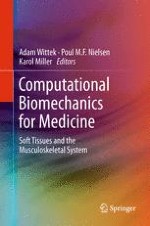2011 | OriginalPaper | Buchkapitel
Computational Foot–Ankle–Knee Models for Joint Biomechanics and Footwear Design
verfasst von : Ming Zhang
Erschienen in: Computational Biomechanics for Medicine
Verlag: Springer New York
Aktivieren Sie unsere intelligente Suche, um passende Fachinhalte oder Patente zu finden.
Wählen Sie Textabschnitte aus um mit Künstlicher Intelligenz passenden Patente zu finden. powered by
Markieren Sie Textabschnitte, um KI-gestützt weitere passende Inhalte zu finden. powered by
Understanding complex human musculoskeletal systems requires an enormous amount of experimental and computational studies. The computational modeling combining anatomic, physiologic and engineering analyses can create a virtual human body to study various activities in a normal and pathological condition. Combining the virtual human body with some kinds of mechanical analyses showed strong potentials in understanding of musculoskeletal biomechanics. Modeling of human joints, such as foot–ankle–knee are most challenging, due to very complex structures. Information on the internal structures as well as foot-support interfacial load transfer during various activities is useful in enhancing our biomechanical knowledge for foot support design and surgical planning. We develop computational models as a digital foot-ankle, which can be used to understand joint biomechanics and design proper foot supports and implant. Three-dimensional geometrically accurate finite element (FE) models of the human foot–ankle–knee structures were developed from 3D reconstruction of MR images of subjects. The foot FE model consists of 28 separate bones, 72 ligaments and the plantar fascia, embedded in a volume of encapsulated soft tissue. The main bone interactions were simulated as contact deformable bodies. The analyses took into consideration the nonlinearities from material properties, large deformations, and interfacial slip/friction conditions. A series of experiments on human subjects and cadavers were conducted to validate the model measurements on in terms of plantar pressure distribution, foot arch and joint motion, plantar fascia strain under different simulated weight-bearing, and orthotic conditions of the foot. The validated models can be used for parametrical studies to investigate the biomechanical effects of tissue stiffness, muscular reaction, surgical and orthotic performances on the foot–ankle complex.
